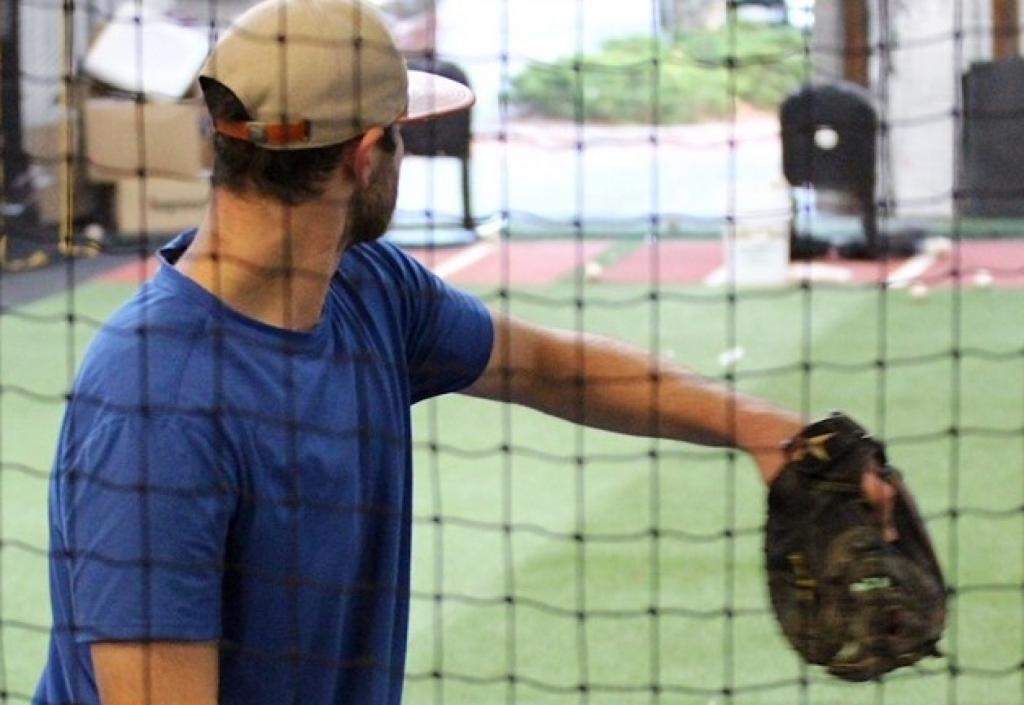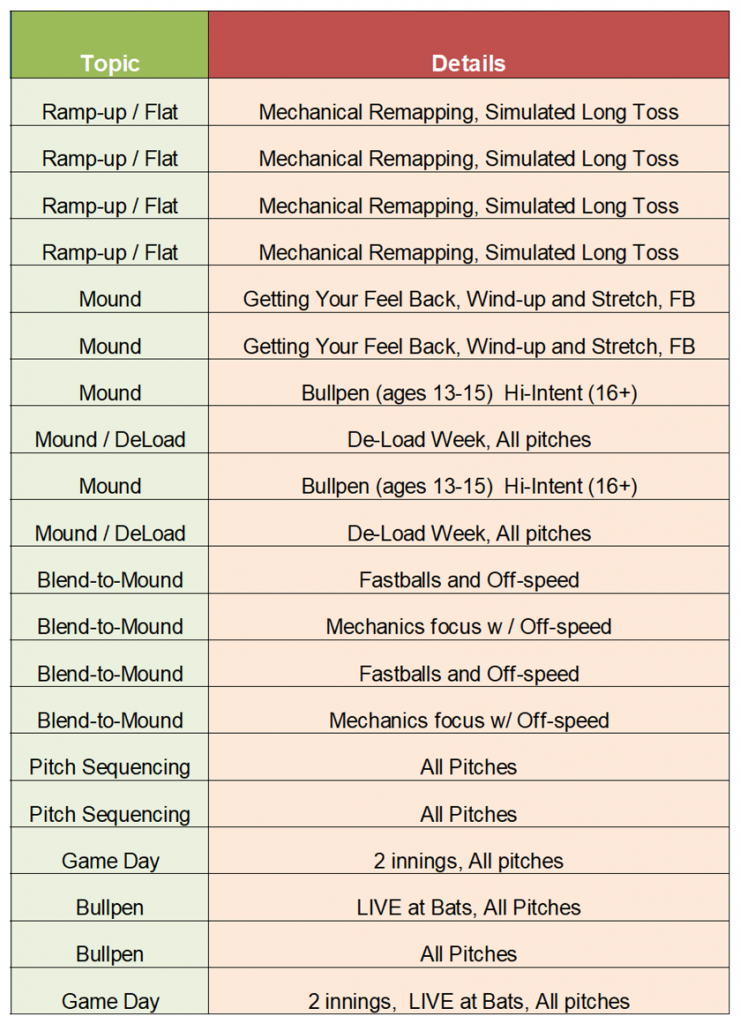
The following is a list of “frequently asked questions” we receive on our off-season pitching program. Hope it’s helpful, but please feel free to reach the front desk at 201-308-3363 with any additional inquiries at any time or set up a visit where we can give you an on-site tour and review the programming.
Pitching Program Q&A
Q: Is your winter pitching program also a velo program?
We understand the role velocity plays in today’s game and although we do not promote our off-season pitching program as a “velo program”, as a practical matter if you’re in the combined pitching and strength program IT IS ONE, but it’s also much more. Our pitchers’ velocities do rise, either during the program or by mid- to late spring for several reasons, including:
-
- Cleaning up your pitching mechanics and disconnects
- Getting you stronger in the weight room
- Getting you mobile (shoulder, hip, etc.)
- Improving your overall athleticism
The net result of these improvements can help increase your velo ceiling and your ability to throw harder. Having said that, every pitcher is unique and different pitchers tend to experience the benefits at different times. Some experience gains during the program, while others not until they face game-like situations and warmer weather in late spring.
Practically speaking, if a pitcher works hard during the off-season and gains 10 lbs. of additional lean muscle mass, it might take him a little time before he can appropriately put that additional strength to work. However, it is common to see velo gains of 2-5 mph, either during the program or by later spring, early summer.
A side note… Sometimes, we have pitchers who begin comparing their pitching velocity in February to the prior fall. This is not an appropriate comparison. Pitchers go through changes during the season and the best way to compare velo from year to year is by comparing it season to season, such as spring to spring or summer to summer.
Q: Do your pitchers ramp-up when you first start throwing again in December? What does it entail?
It is our belief that pitchers need to take time to ramp-up throwing capacity to throw hard while minimizing the risk of injury. When throwing portion of the program begins in mid-December, there is a ramp-up period which includes a series of customized pitching correctives for each pitcher (based off their video analysis) and simulated long toss at no more than 75% intensity. We add stress incrementally over a 3–4-week period, allowing the connective tissue to adapt as it accepts more energy. A proper ramp-up can help prevent issues that may otherwise creep up in late January / early February.
Q: Can you review the pitching portion of the off-season program?
Although, the off-season program begins in late fall, our pitching sessions begin in mid-December and conclude near the end of February. It involves throwing / pitching twice per week and is meant for preparing middle and high school students for the upcoming spring and summer seasons.
The program systemically ramps up our pitchers, transitions them to mound where we work on pitching mechanics and a variety of different types of pitches (FB, CB, CH, etc.), and ultimately work in game-like situations and LIVE at Bats near the back end! In addition, pitchers always begin each session with throwing correctives they have been prescribed individually to ingrain movement patterns specific to their needs.
Here is an approximate timeline of the program (20 sessions, but session counts may vary depending on the calendar from year to year):

Q. Do you teach pitchers how to take care of their arms?
Yes! We have an extensive program around arm care for our athletes and every pitcher in our program learns how to perform proper pre-throwing and post-throwing arm care.
Q: Why do you suggest throwing twice per week?
We believe that it is necessary that pitchers throw at least 2x per week in preparation for the spring. Throwing once a week does not allow the connective tissue of the arm to develop the resiliency necessary to resist the demands of a high-level throw. If you are a high-level thrower or intend on becoming one, throwing once a week simply just does not cut it. If you enroll in our 1x / week program, we highly recommend that you supplement that with additional throwing during the week.
Now, let’s review why this is important. As the season gets closer and you begin to throw harder, the soft tissue does not decide if it wants to participate or not. It can only respond to the stresses you put on it during training and prior bullpens and/or throwing sessions. Therefore, adding an adequate amount of stress to the connective tissue will always force an adaptation that can make that tissue more resilient. This brings us to Davis’ Law, which is used in anatomy and physiology to describe how soft tissue models itself along imposed demands. It simply states as follows:
“Ligaments, or any soft tissue, when put under even a moderate degree of tension, if that tension is unremitting, will elongate by the addition of new material; on the contrary, when ligaments, or rather soft tissue, remain uninterruptedly in a loose or lax state, they will gradually shorten, as the effete material is removed, until they come to maintain the same relation to the bony structures with which they are united that they did before their shortening.”
Q: Do you work on pitch design during the winter program?
The purpose of the winter program is to prepare our athletes for the spring and summer season. In order of priority, we look to address your pitching mechanical disconnects and velocity improvements first, and then focus on other topics, including ball movement and pitch design.
Having said that, much of our pitch design training for pitchers is done during our fall program. But we will selectively incorporate pitch design sessions during the winter months as well. If we believe a pitcher is far along in their mechanics and is ready for the next step, we begin to incorporate pitch design work in the training.
Q: Do you perform video analysis?
Yes, we are big believers in slowing things down and analyzing video. Video analysis helps us break down mechanics, not only from a bio-mechanical standpoint but also from a sequencing / delivery viewpoint. From there, we can better prepare a set of throwing correctives for mechanical remapping.
Since every pitcher is different in their delivery, these programs and correctives are 100% customized for each pitcher in their program and is an integral part of how we help pitchers improve their mechanics and achieve a higher velocity ceiling.
Q: What is the pitcher to pitching coach ratio?
Our pitcher to pitching coach ratio during the winter program is 2 pitchers to 1 coach.
General Questions
Q: What is the difference between your “13- to 16-year-old” and “16 and older” programs?
The difference between the younger and older group is primarily about the weight room and our lifting program.
If you are 13-16 years old and have never trained at RPP before, you should enroll in the younger group which trains twice per week with a strength coach. On the other hand, if you are 16 or older (and have prior RPP training experience) you can seek approval to train in the older group where you can train 4-5x per week. There are several criteria that go into our approval process, including:
-
- 16 years old at time of approval
- Physically mature (examples… 5’9” /170 lbs. or 6’0” / 180 lbs. and NOT 5’10” / 125 lbs.)
- Demonstrate the ability to conduct yourself properly around the weight room
- Be able to train more independently with less direct supervision
Our decision on this topic is solely based on overall safety in the weight room and our belief that the athlete has the ability and desire to train more independently with a more rigorous and demanding weightlifting program. Most 16-year-olds that are new to RPP can get qualified for the older group once they get more experience in the weight room. 17-year-olds are automatically enrolled in the older group.
Q: Is the strength training in group setting or individual?
As mentioned earlier the younger athletes train twice per week in groups of up to six per strength coach. The strength training is baseball-specific and intended for rotational athletes such as pitchers and position players.
The older group of athletes receive more advanced and individualized training programs, and they are expected to be more experienced in the weight room. They have their own customized program which is based on the upfront assessment. They train more independently. However, our coaches are always available to them on the floor to answer questions.
Q: Why do your strength program start in November?
Our off-season strength programs start earlier than most others because much of what we look to attain revolves around getting our athletes stronger and more mobile. Our programs begin in November so that we can begin our work in the weight room. Once we have begun to address the physical needs of our athletes, in December we begin working on the skill side of the equation, whether it be pitching or hitting.
Q: What do you suggest for 2-way players?
We always suggest that 2-way players train as pitchers at RPP, and then hit on days when they are not pitching or throwing. Our pitcher programming provides for more arm care which players could use as well given the volume of games they play during the year.
Q: Can parents watch the sessions?
Yes, parents can join us this year. But first, please check with front desk so that we can manage the process. If you do attend, please stay outside the weight room areas, and please do not engage with the instructors during the sessions. We would be happy to set up a time to review your young athlete’s strengths, weaknesses, and development.
Q: Can we go over the results of the physical and / or video assessments?
Yes. We can provide the results with those who want to review them.
Additional Questions?
Hopefully, we have answered your questions. Please feel free to reach the front desk at 201-308-3363 with any additional inquiries at any time or set up a visit “consult session” where we can give you an on-site tour and review the programming.
If you’d like to be placed on our email list please enter your email address below!
